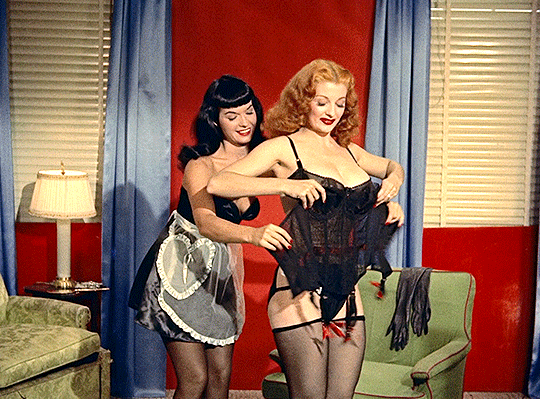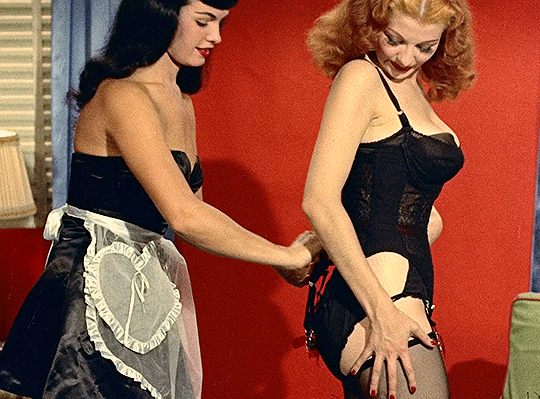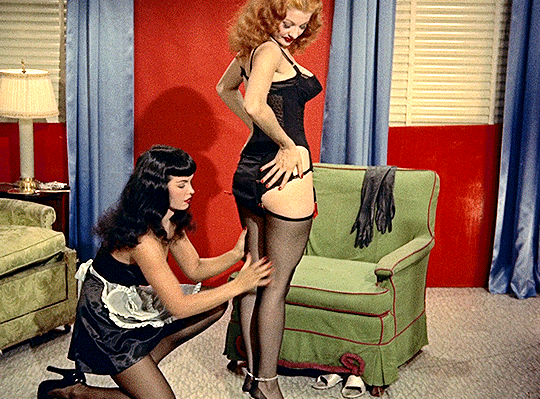#1950s sexploitation
Explore tagged Tumblr posts
Text





Betrayed (1955)
#burlesque gif#initiation gif#50s sexploitation#vintage sleaze#50s showgirls#lingerie and spaghetti#50s models#nudie cuties shorts#1950s#1955
144 notes
·
View notes
Text
On January 14, 1956, The Flesh Merchant premiered in Austin, Texas.

#the flesh merchant#the wild and the wicked#austin texas#w. merle connell#exploitation film#grindhouse film#grindhouse#drive in movies#classic film#melodrama#sexploitation film#1950s#1950s film#crime film#crime thriller#art#movie art#drawing#movie history#pop art#modern art#pop surrealism#cult movies#portrait#cult film
2 notes
·
View notes
Text


Vintage Paperback - Burial Of The Fruit by David Dortort
Avon (1951)
#Paperback Cover#Paperback Art#Sexploitation#David Dortort#Burial Of The Fruit#Vintage#Art#Paperback#Paperbacks#Avon#Avon Books#Juvenile Delinquency#1951#1950s#50s
13 notes
·
View notes
Text

The Desperate Women (1954)
21 notes
·
View notes
Text
A Comprehensive List of Pre-21st Century Lesbian Films
There seems to be a lot of interest in older/more niche films with lesbian themes so I've been putting together this list. I'm going to keep adding to it as I find more films so feel free to let me know if I'm missing anything! Enjoy!
Quick disclaimer: Some of these films contain problematic elements such as racism, homophobia, sexism and so on. This list is not an endorsement of all these films, it is only for archival purposes. As I have not seen all these films I cannot provide accurate content warnings, so please do your own research before watching.
1880 - 1919
The Kiss (1882), Dir. Eadweard Muybridge [SHORT, SILENT, ZOOPRAXISCOPE]
Pierrette’s Escapades (1900), Dir. Alice Guy [SHORT, SILENT, HAND TINTED]
At the Floral Ball (1900), Dir. Alice Guy [SHORT, SILENT, HAND TINTED]
Midwife to the Upper Class (1902), Dir. Alice Guy [SHORT, SILENT, COMEDY]
The Jester’s Joke (1910), Dir. Walter R. Booth [SHORT, SILENT, COMEDY]
Zapata’s Gang (1914), Dir. Urban Gad [SILENT, CRIME, COMEDY]
Filibus (1915), Dir. Mario Roncoroni [SILENT, ACTION]
1920-1939
Manslaughter (1922), Dir. Cecil B. Demil [SILENT, DRAMA]
The Girl in Tails (1926), Dir. Karin Swanstrom [SILENT, COMEDY]
Wings (1927), Dir. William A. Wellman [SILENT, WAR, ACTION]
Pandora’s Box (1929), Dir. G.W. Pabst [SILENT, DRAMA]
Diary of a Lost Girl (1929), Dir. G.W. Pabst [SILENT, DRAMA]
Morocco (1930), Dir. Josef von Sternberg [DRAMA, ROMANCE]
Mädchen in Uniform (1931), Dir. Leontine Sagan [DRAMA, COMING OF AGE]
Queen Christina (1933), Dir. Rouben Mamoulian [DRAMA, PERIOD]
Fukujuso (1935), Dir. Jiro Kawate [SILENT, DRAMA]
The Tomboy (1936), Dir. Jean de Limur [DRAMA]
Girls’ Club (1936), Dir. Jacques Deval [COMEDY, CRIME]
1940-1959
Jenny Lamour (1947), Dir. Henri-Georges Clouzot [CRIME, DRAMA]
Thirst (1949), Dir. Ingmar Bergman [DRAMA]
Caged (1950), Dir. John Cromwell [DRAMA]
Girl with Hyacinths (1950), Dir. Hasse Ekman [MYSTERY, NOIR]
Olivia (1951), Dir. Jacqueline Audry [DRAMA]
No Exit (1954), Dir. Jacqueline Audry [DRAMA]
La Garçonne (1957), Dir. Jacqueline Audry [DRAMA]
The Twilight Girls (1957), Dir. Andre Hunebelle [COMEDY, DRAMA]
Mädchen in Uniform (1958), Dir. Geza von Radvanyi [DRAMA, COMING OF AGE, REMAKE]
1960-1969
Blood and Roses (1960), Dir. Roger Vadim [VAMPIRE, HORROR, EROTIC]
Léon Morin, Priest (1961), Dir. Jean-Pierre Melville [DRAMA]
The Girl with the Golden Eyes (1961) Dir. Jean-Gabriel Albicocco [DRAMA]
The Children’s Hour (1961), Dir. WIlliam Wyler [DRAMA]
Walk on the Wild Side (1962), Dir. Edward Dymitrik [DRAMA]
Manji (1964), Dir. Yasuzo Masumura [DRAMA]
With Beauty and Sorrow (1965), Dir. Masahiro Shinoda [DRAMA]
Faster, Pussycat! Kill! Kill! (1965), Dir. Russ Meyer [EXPLOITATION]
Daisies (1966), Dir. Věra Chytilová [AVANT GARDE, COMEDY, DRAMA]
The Group (1966), Dir. Sidney Lumet [DRAMA]
La Religieuse (1966), Dir. Jacques Rivette [DRAMA]
Persona (1966), Dir. Ingmar Bergman [AVANT GARDE, PSYCHOLOGICAL, DRAMA]
Belle De Jour (1967), Dir. Luis Bunuel [DRAMA]
The Fox (1967), Dir. Mark Rydell [DRAMA]
Les Biches (1968), Dir. Clauthde Chabrol [DRAMA, EROTIC]
The Killing of Sister George (1968), Dir. Robert Aldrich [DRAMA, EXPLOITATION]
Therese and Isabelle (1968), Dir. Radley Metzger [ROMANCE, DRAMA, EROTIC]
The Girl from Pussycat (1969), Dir. Smythe David [SEXPLOITATION]
Check to the Queen (1969), Dir. Pasquale Festa Campanile [DRAMA, EROTIC]
The Others (1969), Dir. Renzo Maietto [DRAMA]
1970-1979
Valerie and Her Week of Wonders (1970), Dir. Jaromil Jires [AVANT GARDE, DRAMA, COMING OF AGE]
Beyond the Valley of the Dolls (1970), Dir. Russ Meyer [COMEDY, MUSICAL, MELODRAMA]
Midnight Virgin (1970), Dir. Shogoro Nishimura [DRAMA, EROTIC]
The Conformist (1970), Dir. Bernardo Bertolucci [POLITICAL DRAMA]
Multiple Maniacs (1970), Dir. John Waters [COMEDY]
The Dark Side of Tomorrow (1970), Dir. Jack Deerson, Barbara Peeters [DRAMA]
Nightmares Come at Night (1970), Dir. Jesús Franco [DRAMA]
The Vampire Lovers (1970), Dir. Roy Ward Baker [VAMPIRE, HORROR, EROTIC]
The Shiver of the Vampires (1971), Dir. Jean Rollin [VAMPIRE, EROTIC]
Girl Slaves of Morgana Le Fay (1971), Dir. Bruno Gantillon [EROTIC]
Daughters of Darkness (1971), Dir. Harry Kumel [VAMPIRE, EROTIC]
Vampyros Lesbos (1971), Dir. Jesús Franco [VAMPIRE, EXPLOITATION, EROTIC]
Daughter of Dracula (1972), Dir. Jesús Franco [VAMPIRE, EROTIC]
Intimate Confessions of a Chinese Courtesan (1972), Dir. Chor Yuen [MARTIAL ARTS, DRAMA, EROTIC]
The Bitter Tears of Petra von Kant (1972), Dir. Rainer Werner Fassbinder [DRAMA]
The Beguines (1972), Dir. Guy Casaril [DRAMA, EROTIC]
Don Juan or If Don Juan Were a Woman (1973), Dir. Roger Vadim [DRAMA, EROTIC]
Lemora: A Child’s Tale of the Supernatural (1974), Dir. Richard Blackburn [HORROR, COMING OF AGE]
Vampyres (1974), Dir. Jose Ramon Larraz [VAMPIRE, EXPLOITATION, EROTIC]
Foxy Brown (1974), Dir. Jack Hill [BLAXPLOITATION, ACTION]
Je Tu Il Elle (1974), Dir. Chantal Ackerman [DRAMA]
Black Emanuelle (1975), Dir. Bitto Albertini [SEXPLOITATION]
Successive Slidings of Pleasure (1974), Dir. Alain Robbe-Grillet [HORROR, AVANT GARDE, EROTIC]
Picnic At Hanging Rock (1975), Dir. Peter Weir [MYSTERY, DRAMA]
Word Is Out: Stories of Some of Our Lives (1977), Dir. Mariposa Film Group, et. al [DOCUMENTARY]
Bilitis (1977), Dir. David Hamilton [EROTIC]
Alucarda (1977), Dir. Juan López Moctezuma [VAMPIRE, HORROR, EXPLOITATION]
Fascination (1979), Dir. Jean Rollin [VAMPIRE, HORROR, EROTIC]
See Here My Love (1979), Dir. Hugo Santiago [MYSTERY, DRAMA]
1980-1989
Simone Barbes or Virtue (1980), Dir. Marie-Claude Treilhou [DRAMA]
Personal Best (1982), Dir. Robert Towne [SPORTS, DRAMA]
Scrubbers (1982), Dir. Mai Zetterling [DRAMA]
The Living Dead Girl (1982), Dir. Jean Rollin [ZOMBIE, HORROR]
Audience (1982), Dir. Barbara Hammer [DOCUMENTARY]
The Hunger (1983), Dir. Tony Scott [VAMPIRE]
Lianna (1983), Dir. John Sayles [DRAMA]
La Pirate (1984), Dir. Jacques Doillon [DRAMA]
Desert Hearts (1985), Dir. Donna Deitch [ROMANCE, DRAMA]
Anne Trister (1986), Dir. Lea Pool [DRAMA]
Kamikaze Hearts (1986), Dir. Juliet Bashore [DOCUFICTION]
Working Girls (1986), Dir. Lizzie Borden [DRAMA]
I’ve Heard the Mermaids Singing (1987), Dir. Patricia Rozema [COMEDY]
No No Nooky T.V. (1987), Dir. Barbara Hammer [COMEDY, SHORT]
1990-1999
The Company of Strangers (1990) Dir. Cynthia Scott [DOCUFICTION]
Salmonberries (1991), Dir. Percy Adlon [DRAMA]
Thelma & Louise (1991), Dir. Ridley Scott [CRIME, DRAMA]
Twin Peaks: Fire Walk with Me (1992), Dir. David Lynch [HORROR, AVANT GARDE]
Nitrate Kisses (1992), Dir. Barbara Hammer [DOCUMENTARY]
Flaming Ears (1992), Dir. A. Hans Scheirl, Dietmar Schipek, and Ursula Pürrer [AVANT GARDE, SCI-FI]
Fresh Kill (1994), Dir. Shu Lea Cheang [SCI-FI, AVANT GARDE]
Heavenly Creatures (1994), Dir. Peter Jackson [CRIME, THRILLER, BIOPIC]
Go Fish (1994), Dir. Rose Troche [COMEDY, DRAMA, ROMANCE]
The Celluloid Closet (1995), Dir. Rob Epstein & Jeffrey Friedman [DOCUMENTARY]
The Incredibly True Adventure of Two Girls in Love (1995), Dir. Maria Maggenti [COMEDY, DRAMA]
When Night is Falling (1995), Dir. Patricia Rozema [DRAMA]
BloodSisters: Leather, Dykes, and Sadomasochism (1995), Dir. Michelle Handelman [DOCUMENTARY]
Bound (1996), Dir. The Wachowskis [CRIME, THRILLER]
The Watermelon Woman (1996), Dir. Cheryl Dunye [ROMANCE, DRAMA, COMEDY]
Irma Vep (1996), Dir. Olivier Assayas [DRAMA]
Nowhere (1997), Dir. Gregg Araki [BLACK COMEDY, DRAMA]
Gia (1998), Dir. Michael Cristopher [BIOPIC]
High Art (1998), Dir. Lisa Cholodenko [DRAMA]
Election (1999), Dir. Alexander Payne [COMEDY]
Being John Malkovich (1999), Dir. Spike Jonze [COMEDY, FANTASY]
But I’m A Cheerleader (1999), Dir. Jamie Babbit [ROMANCE, COMEDY]
Adolescence of Utena (1999), Dir. Kunihiko Ikuhara [ANIME, DRAMA, COMING OF AGE]
#lesbian#wlw#dykeposting#sapphic#lesbian history#lesbian art#lesbian film#lgbt history#lgbt film#gay film#compilation#silent film#early lesbian film#film history#archival
356 notes
·
View notes
Text

Died on this day: Britain's answer to Jayne Mansfield, TV personality, b-movie starlet, pin-up, Stockport’s finest export and all-round glamour girl (when that was still a legit job title) – the fabulously ridiculous Sabrina (née Norma Ann Sykes, 19 May 1936 - 24 November 2016)! In her 1950s and 60s heyday, the sex kitten’s sensational 42½ inch bust and a 19-inch waist earned her lecherous publicity titles like “Britain's Finest Hourglass”, “Queen of the Big Top" and "The Juliet with the Built-in Balcony.” Sabrina also had great taste in men: she enjoyed a tempestuous fling with Hollywood film noir tough guy Steve Cochran in the fifties. I treasure Sabrina’s gloriously awful performance in 1962 American sexploitation masterpiece Satan in High Heels. But I also clearly need to seek out The Ice House (1969) (aka Love in Cold Blood, aka The Passion Pit) in which Sabrina plays Venus De Marco, a role originally intended for Jayne Mansfield before her death. (The part was also offered to Mamie Van Doren, Diana Dors and Joi Lansing). Pictured: Sabrina in Las Vegas, 1962.
#lobotomy room#satan in high heels#sabrina#norma sykes#sex kitten#vintage smut#vintage sleaze#the british jayne mansfield#starlet#pinup#pin up#retro pinup#vintage pin up#platinum blonde#kitsch#retro#beehive hairdo
25 notes
·
View notes
Text

Pat Barrington.
Pat screamed feminine sex appeal, like 'I AM WOMAN!!' at top decibels.
Not such a happy childhood, and lived the life of a stripper with a few forays into film. But her looks and body - oh, my! I would have loved to have her body in her prime!!
Her web bio:
Pat Barrington was an extremely buxom, curvy, and drop-dead gorgeous blonde topless dancer who popped up in a handful of enjoyably trashy softcore sexploitation features throughout the 1960's, often for producer Harry H. Novak's Boxoffice International Pictures and directed by William Rotsler.
Barrington was born Patricia Annette Bray on October 16, 1939 in Charlotte, North Carolina. Her mother Willie Jo Bray had a fling with a local man named Claude Weidenhause and became pregnant at age sixteen. Weidenhause had already left by the time Barrington was born. Pat moved with her mother Willie Jo to Richmond, Virginia when she was only two years old. Willie Jo married another man, Eugene Lee Barringer. But the marriage was short-lived and Pat found herself moving once again with her mother to Hyattsville, Maryland. Willie Jo subsequently married a former Marine suffering from post-traumatic stress disorder. Upset with the unstable situation at home, Barrington left her mother and went out to fend for herself after her sophomore year in high school.
Pat relocated to Baltimore, Maryland, where she hooked up with an Italian-American mobster named Bob. Barrington got married for the first time in the late 1950's. But Pat soon left her first husband after the relationship became abusive. Bob helped Barrington get back on her feet by securing her a job as an exotic dancer. Pat then made a name for herself in Washington, D.C. dancing under the name of Vivian Storm. Barrington caught the eye of local jazz musician Melvin Rees and moved into Rees's abode in Hyattsville, Maryland in 1959. Pat moved down south with Rees in 1960. Alas, Rees was found guilty of murdering a Virginia family and was sentenced to life in prison.
Barrington moved to Los Angeles, California in 1962 and promptly got a job dancing at the prestigious nightclub The Classic Cat. Pat then decided to pursue a modeling career and subsequently started posing in spreads for various men's magazines as well as numerous commercial layouts. After an ill-advised foray into dancing in Las Vegas, Barrington returned to Los Angeles and resumed her career as a model while still dancing on the side. Pat eventually began auditioning for film work in the mid-1960's. Barrington achieved her greatest cult cinema fame as the female lead in Stephen C. Apostolof's unintentionally hilarious horror camp hoot Orgy of the Dead (1965), in which she also performs one of her patented steamy nude dances as the painted Gold Girl. Barrington had another rare substantial starring part as a bored housewife who works as a high-priced call girl in the seamy Agony of Love (1966). More often, though, the stunning and spectacularly alluring Pat was relegated to secondary roles as a go-go dancer in such delightfully down'n'dirty low-grade fare as Lila (1968), The Girl with the Hungry Eyes (1967) and Sisters in Leather (1969). She appeared as herself in both the lurid mondo item Hedonistic Pleasures (1969) and Russ Meyer's blithely silly documentary Mondo Topless (1966). During this time Barrington was briefly married to cinematographer Robert Caramico.
After calling it quits as an actress, Pat left Los Angeles and moved to New Jersey with a singer named Romeo. Barrington soon found gainful employment dancing in clubs up and down the East Coast under the pseudonym of Princess Jajah. In the mid-1970's Pat branched out into topless dancing. She settled down in Cliffside Park, New Jersey in 1980. Barrington eventually dumped Romeo and became involved with a much younger man named Robert. Pat moved with Robert to Fort Lauderdale, Florida in 1984. Pat worked as a stripper using the name Yvette at assorted seedy clubs throughout Florida. After retiring from dancing in the early 1990's, Barrington went on to work as a telemarketer. In her later years Pat also helped local animal rescue groups (she was a lifelong lover of animals). Barrington died from lung cancer at age 74 on September 1, 2014.
29 notes
·
View notes
Text
JOSEPH W. SARNO, THE HISTORICAL FILM FIGURE OF SEXPLOITATION OF THE 60's & 70's

Joseph W. Sarno was an American film director and screenwriter. born on March 15, 1921. He grew up in Amityville on Long Island and died of natural causes on April 26, 2010 at the age of 89 in his native New York City. Sarno married Peggy Steffans, who was younger than he and was a non-sex performing actress and costumer in some of his films, and they had a son.
Sarno emerged from the semi-pornographic sexploitation film genre of the 1950s & 1960s; he had written and directed approximately 75 theatrically released feature films in the sexploitation, softcore and hardcore genres as well as a number of shot-on-video features for the 1980s hardcore video market.
Sarno, was considerad a pioneer in the genre of sexploitation film.
A Life in Dirty Movies is a 2013 Swedish documentary about Sarno and his wife, and their attempt to make one last film.
940-1 LINK https://ok.ru/video/1115493894694
SEXPLOITATION FILM
What is it?

A sexploitation film (or sex-exploitation film) is a class of independently produced, low-budget feature film that is generally associated with the 1960s and early 1970s, and that serves largely as a vehicle for the exhibition of non-explicit sexual situations and gratuitous nudity. The genre is a subgenre of exploitation films. The term "sexploitation" has been used since the 1940s.
Moonlighting Wives (1966).
940-2 LINK: https://ok.ru/video/4932160785094
In USA, exploitation films were generally exhibited in urban grindhouse theatres, which were the precursors to the adult movie theaters of the 1970s and 1980s that featured hardcore pornography content. In Latin America (most notably in Argentina), exploitation and sexploitation films had meandering and complex relations with both moviegoers and government institutions: they were sometimes censored by democratic (but socially conservative) administrations and/or authoritarian dictatorships (especially during the 1970s and 80s), and at other times they enjoyed an important success at the box office.
Among his best-known films in the genre is Sin in the Suburbs (1964), which is about wife swapping, ...
940-3 LINK: https://ok.ru/video/4506488277662
The term soft-core is often used to designate non-explicit sexploitation films after the general legalisation of hardcore content. Nudist films are often considered to be subgenres of the sex-exploitation genre as well. "Nudie" films and "Nudie-cuties" are associated genres.
Beginning in 1968, Sarno's work became somewhat more explicit, predicting the emergence of soft-core. His breakthrough feature Inga (1968) ...
940-4 LINK: https://ok.ru/video/2527643372093
... was one of the first X-rated films released in the United States. Other noteworthy soft-core features include All the Sins of Sodom (1968),
940-5 LINK https://ok.ru/video/4642191968926
Critical reputation
Singled out for praise by critic Andrew Sarris during the 1970s, Sarno's work has been acknowledged in recent years by tributes at the New York Underground Film Festival, the Torino Film Festival in Turin, Italy, the Cinémathèque Française in Paris, and The Andy Warhol Museum.
Sarno has had a tribute at the British Film Institute in London and has given an honorary lecture at Lund University in Sweden.
His career is being researched for a comprehensive biography by film historian Michael J. Bowen.
Virgile Iscan interviewed Joe Sarno and his wife shortly before Sarno's death in 2010. The interviews appear in Iscan's documentary The Divine Joe Sarno.
Filmography
Deep Inside (1968)
940-6 link https://ok.ru/video/6550569880222
Joseph W. Sarno - Wikipedia
2 notes
·
View notes
Text

Teaserama is presented as a documentary film, with all actors and actresses playing themselves. It opens with Bettie Page assisting Tempest Storm with her brassiere. Afterwards, when the show begins, Page introduces the acts by showing placards with the names of the acts. Stripteases are provided by Tempest Storm, Chris La Chris, Twinnie Wallen, Trudy Wayne, Vicki Lynn, and Cherry Knight. Burlesque comedy is provided by Joe E. Ross and Dave Starr.
Watch the film below

Varietease is a 1954 American burlesque film and the first such directed by Irving Klaw.[1][2] According to its plot, the iconic pin-up model Bettie Page performs a burlesque show alongside Lili St. Cyr, Chris La Chris, Vicki Lynn, Bobby Shields, and others.
Synopsis
[edit]
Varietease was Klaw's first documentary film reflective of burlesque clubs of the 1950s.[1] Master of ceremonies Bobby Shields introduces the film's acts. Bettie Page performs a nudity-free Dance of the Seven Veils but teases in only removing four veils. Lili St. Cyr does four separate sequences, wherein she dresses and undresses to her underwear. Bettie Page returns presenting act cards while performing a few burlesque moves as she presents. Following are a comic, a female impersonator, the Barrow and Rodgers dance team, additional songs, and can-can dancers. The film ends with a pastie-covered reveal of Lili St. Cyr's chest.









BETTIE PAGE & TEMPEST STORM in TEASERAMA — 1955, dir. Irving Klaw
5K notes
·
View notes
Text
Hell Is a Place Called Hollywood (1950)

These Girls Are Fools (aka. Hell Is a Place Called Hollywood) (1950) Short, Drama, Exploitation


A beauty queen called Sheila Anderson wins a part in a Hollywood motion picture. The film turns out to be a cheap nudie film, she is then shunned by the theatrical community and ends up working as a nude model. Soon she is old news and struggles to get work, resulting in abject poverty.
youtube
"exploitation", "fetish film", "stag film", "sexploitation"
0 notes
Text
I went in kind of expecting a 'gay sexploitation' and sure that SOUNDS fun but with its reputation and the 1950s of it all I was worried it'd be not just lurid-in-a-bad-way but quite a preachy, snide piece of work.
But there's so much great stuff here! The lighting alone is worth the price of admission.
#caged#cinematography#filmmaking#shot zero#it IS pretty gay-coded including the nastiest piece of work but not *just* the bad guys are gay
0 notes
Photo




Girls Incorporated (1959)
#girls incorporated gif#b-movies gif#50s movies#50s pinup girls#barry mahon#50s sexploitation#clelle mahon#venus#1950s#1959#gif#chronoscaph gif
918 notes
·
View notes
Text

Broadway Burlesque (1951)
64 notes
·
View notes
Text
On July 13, 1995 Glen or Glenda premiered on German television.








#glen or glenda#ed wood#ed wood jr.#lgbtq film#lgbtq fan art#bela lugosi#b movies#cult cinema#fan art#1950s movied#sexploitation film#movie art#art#drawing#movie history#pop art#modern art#pop surrealism#cult movies#portrait#cult film#germany#television
3 notes
·
View notes
Text
I think the context was a combination of two things:
Swedish politics in the 1970s were radically progressive (this was the heyday of social democratic and feminist reform in Sweden, when our welfare state expanded massively), which seriously spooked more conservative societies.
A slew of Swedish erotic and sexploitation movies, beginning in the 1950s and continuing well into the 70s.
It goes without saying that you'll often encounter prejudices that wouldn't fly today when you take in older media, but sometimes you also encounter prejudices which simply have no contemporary analogue. I've been taking in a lot of American media from the 1970s lately, for example, and there seems to be this whole thing about the moral degeneracy of the Swedish going on – and while I know there's probably a fascinating cultural context to that, it never stops feeling vaguely like I'm somehow being pranked.
2K notes
·
View notes
Text

1954, starring Joanne Arnold, PMOM May 1954
12 notes
·
View notes